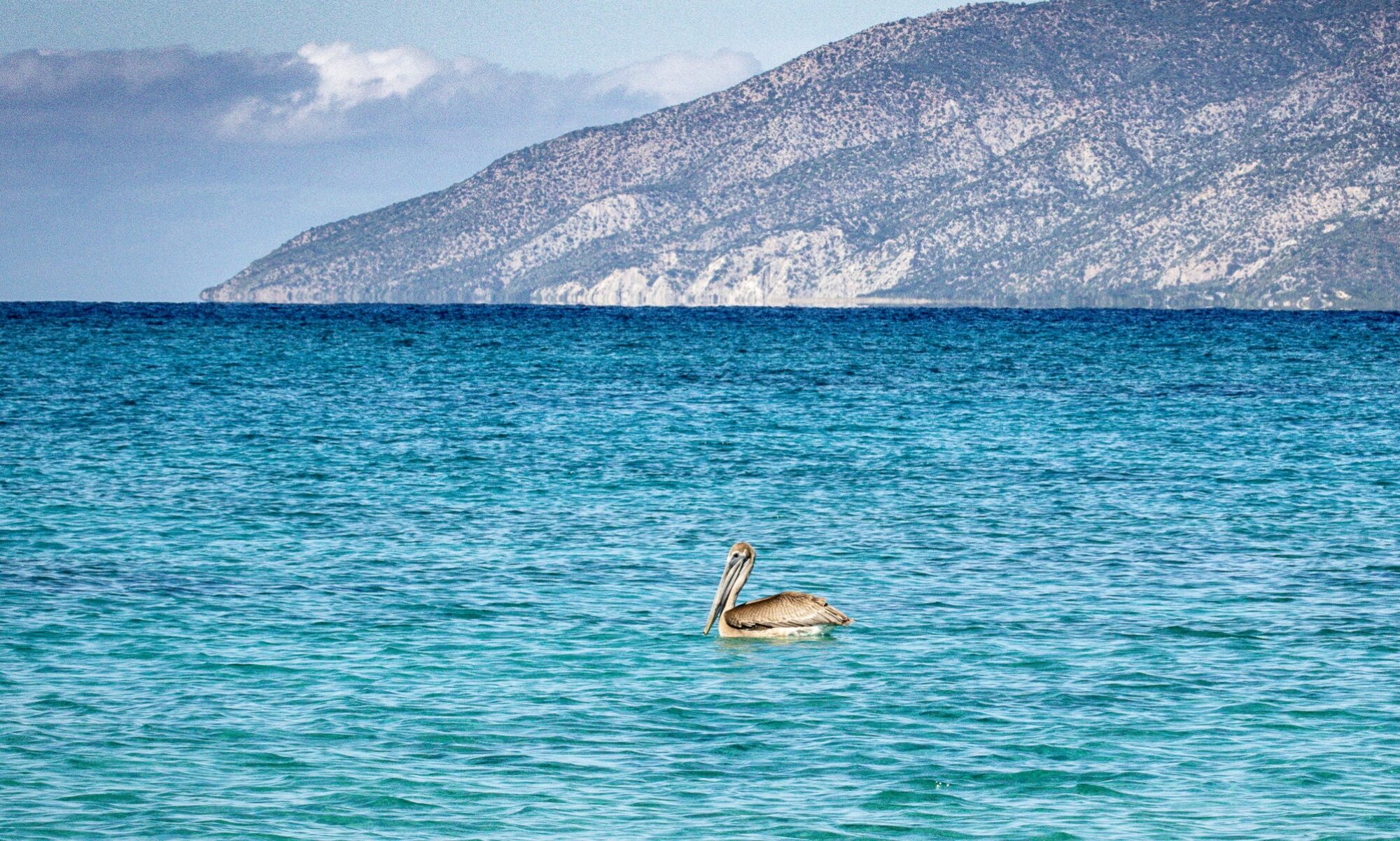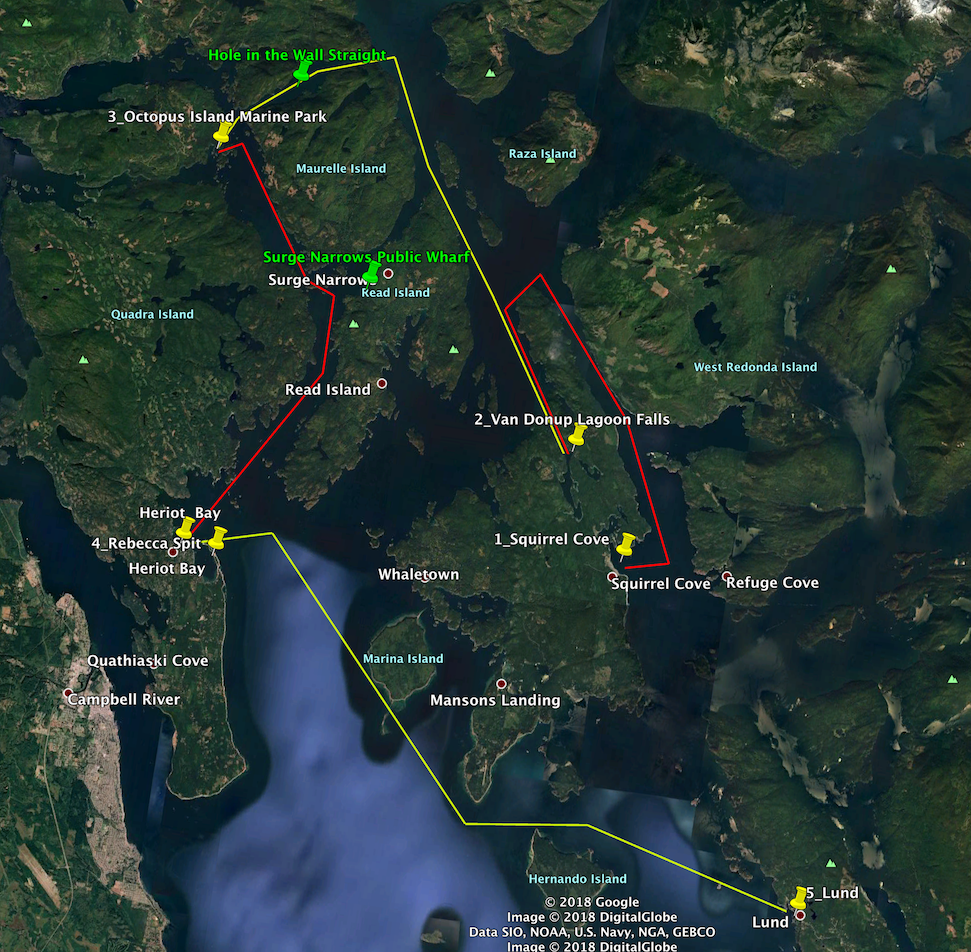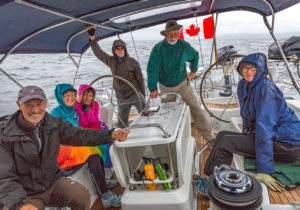
The lovely waters of Desolation Sound, allegedly named by a disgruntled Captain Vancouver in 1792, is the largest marine park in British Columbia and is loved by boaters and kayakers from all over the world for its beauty, wildness, and accessibility. Sooney and I accepted an extraordinary offer from Capt. Harris (a Canadian Academy colleague from the early 80’s) to help crew the Jeanneau 45 Sun Odyssey, Sailaway. (Here’s a YouTube video showcasing the yacht.)
Mind you, Sooney and I had absolutely zero sailing experience and were quite confident maneuvering our 13′ inflatable kayak around mountain lakes. We happily learned that our inexperience was hardly a handicap as we held our own in keeping the sails up…and down…and up…etc. Sooney collaborated with Jane and Julie to plan for, shop for, and prepare wonderful meals (and cocktails) in some very difficult conditions.
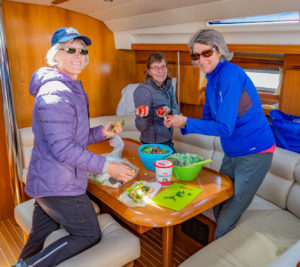
The galley was little more than twice the size of our camper’s but built into the counters were coolers that kept everything fresh, frozen, and tasty. There were 3 staterooms below deck, 2 latrines/showers, and a salon in which we took our meals in inclement weather. The salon doubled as Capt. Harris’s bunk after everything was tidied up, the boat safely anchored, and the coffee percolator set up for my big job each morning (when Dave didn’t beat me to it). The percolator was, by the way, a sentimental reconnect with my parent’s preferred choice of coffee preparation although the brew we perked, using robust dark roast beans, was a far cry from my parents’ swill. That said, there’s nothing quite like the aroma released when opening a pressurized can of coffee, be it Maxwell House, Folgers, Yuban, Hills Brothers; you know the genre. And those cans! How handy they were for storing stuff in the garage, cleaning paint brushes, and piling up because, like yoghurt tubs, you simply couldn’t toss ’em out. But I digress.
We sailed from the Comox Marina Sunday morning after a thorough check-out by the charter company. That’s understandable since Sailaway was privately owned and leased to the Desolation Sound Yacht Charters on a time-share basis. The only problem was the GPS-driven navigation system was broken and we ended up using software installed on the personal tablet of the check-out guy. That proved invaluable as we encountered a fair share of rocks, reefs, and ledges that seek out unwary skippers. Thankfully, we experienced none of those calamities and here I sit, safely accommodated in Victoria’s James Bay Inn, writing an account of our journey on the 1911-era hotel’s veranda with horse-drawn carriages clopping by every 7-8 minutes below on Government St. Quite charming, actually.
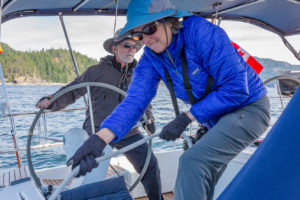
Our itinerary for the week was carefully plotted out by Capt. Harris and he patiently (and kindly) assigned us sailing tasks appropriate to our abilities. Everybody chipped in willingly and the 7 of us were a model of cooperation. Operating the winch that raised and lowered the anchor (and roughly 80 meters of HEAVY chain) was aptly handled by Jane and Rick. Hoisting the mainsail required considerable strength and stamina (Rick & Julie) while lowering it (my other job) a different skill set—balancing oneself on the unsteady deck and stowing the rapidly furrowing sail into its canvas sleeve attached to the boom. There was also a jib sail above the bow that was coiled cleverly when not used but unfurled quickly and securely by winches on either side of the boat. Sooney and Jane locked down that assignment. 1st Mate Dave was nearly always manning the wheel (when he wasn’t doing dishes), keeping us on course and bringing the bow into the wind when raising & lowering the mainsail. Both he and Capt. Harris had navigational training and diligently monitored our course (and depth, wind speed and direction) using specialized software connected via Bluetooth to a GPS antenna. Sailing without those electronically devices must have been disconcerting, indeed. Maybe that’s why Capt. Vancouver named the area the Desolation Sound.
For 6 days and nights, we explored a wild variety of anchorages, narrow straits, and hikes ashore when appropriate. Just getting off the boat now and again was a special treat; I can’t remember experiencing such a lengthy confinement—jail would be a terminal sentence. Here’s our route and a brief annotation about each:
Day 1 (Sunday 6/24): – We departed Comox and, due to an undesirable wind direction, motored across Strait of Georgia toward Lund and then headed north to our anchorage in Squirrel Bay (east side of Cortes Isl.)
Day 2 (6/25): In favorable wind, we sailed to Hàthayim Marine Park accessed via Von Donup Inlet, Cortes Island. The park is a partnership between a First Nation community and the Canadian regional parks system. En-route, we visited Teakerne Arm Marine Park, W. Redonda Island, for a hike (and swim) in Cassel Lake. We employed a “stern-to” anchorage where Rick kayaked to shore and connected Sailaway via rope to the provided iron ring. The crew then rowed to the dinghy dock and hiked to the lake. Note: the entrance appeared narrow although there was ample room to motor into the inlet. Danger lurked in the form of a rock with less than 2 meters of water above it (only visible at Low Water). That complicated things as our keel extended 6′ beneath the boat.
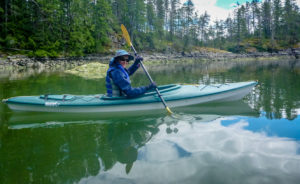
Day 3 (6/26): We sailed/motored through “Hole in the Wall” strait to Octopus island Marine Park, a lovely area where Sooney and I kayaked in the hard shells.
Day 4 (6/27): We sailed/motored through “Surge Narrows” and anchored adjacent to Rebecca Spit. From there, we attached the motor to the dinghy and took shuttles to Heriot Bay where we dined. Both “Hole In The Wall” and “Surge Narrows” required passage at “Slack Tide” (a short period in a body of tidal water when the water is completely unstressed, and there is no movement either way in the tidal stream). Rick and Julie, both experienced sea kayakers, shared tales of riding some really exciting tidal movement. In a sailboat, it was imperative to time our passage through both of these treacherous waters at “slack” for both depth and stability.
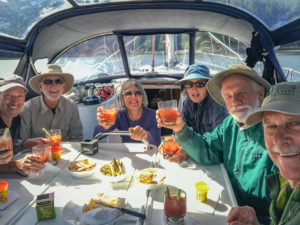
Day 5 (6/28): Sailed in rough weather to Lund where we snagged the last available space in the marina (allowing us to walk, rather than dinghy, to a great meal and live music at the Boardwalk restaurant, Sooney’s 7am bun-run to Nancy’s for some yummy calories, and flush toilets and hot showers!). Lund is a geographical landmark, by the way, as it’s the end (or beginning) of Hwy. 101 that continues 9,000 miles to the tip of Chile.
Day 6 (6/29): We sailed in exciting water across the Straits of Georgia to Sandy Beach (on Denman Island) and, being as we arrive at low tide, enjoyed a wonderful walk across the exposed strait to Tree Island. This was our final night sleeping on our boat, and we enjoyed a gorgeous sunset while playing one of the many games Jane thoughtfully prepared for our journey. A particularly fun one was called “Salad Bowl” that we customized by focusing on a northwest theme.
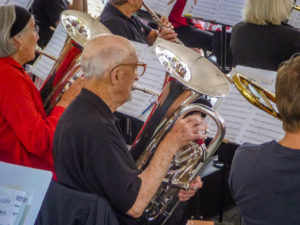
Day 7 (6/30): We motored in calm water back to the Comox Marina. From there, Dave and Jane headed back to Ashland and the rest of us enjoyed an additional day wine tasting local varietals and scooping up Croc knock-offs at Dollarama for $4. Our final day was appropriately spent celebrating Canada Day, highlighted by Rick and his 94-year-old father, Doug, playing together in the Comox Valley Concert Band.
